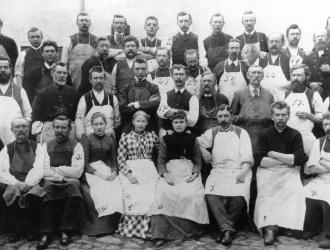
Industrialization and Transport
From about 1850 and onwards the industrialization had momentum which meant a shift from handicraft to factory production. Industries such as iron and metal, textile, sugar, tobacco, breweries and silvery production which marked the industrialization in Fredericia emerged.
In Fredericia there were several cast iron works which among other things produced farming tools and other items made of cast iron. Outstanding in this respect is the Voss Factory which produced brass and bronze objects for domestic use and later resorted to kitchen ware.
In 1865 J.P. Schmidt Junior Cigar and Tobacco Factories opened a branch in Fredericia. Here one of the first trade unions was formed as soon as in 1865 and Stauning who later became Prime Minister for the Social Democratic Party worked here from 1891 to 1893.

Cohr´s silvey factory had been developed industrially from 1884. The firm was one of Fredericia´s most significant which among other things produced a 14 carat gold crown for the sarcophagus of King Christian the 9th .
The first habour project became a reality from 1808 to 1816. The construction was made for merchant ships but didn´t have much success the first years. From the 1850s and onwards the harbor was extended by boat harbor, a shipyard and other industrial facilities because the great depth meant that large merchant ships could harbor.
In the years after the arrival of the railroad to Fredericia in 1866 three ferry docks for the transportation of trains across Little Belt. From the 1920s until the inauguration of the Little Belt Bridge in 1935 the ferries also carried cars across the Belt.
Fredericia thus became the most important traffic junction of the new national network of railroads which attracted more companies. At the same time the town became a center of mail distribution as well as European telegraph communication and the number of inhabitants doubled between 1860 and 1900.
Galleries with the building of the Little Belt Bridge, transport, or industry in Fredericia.